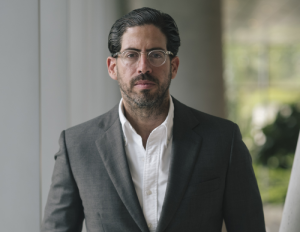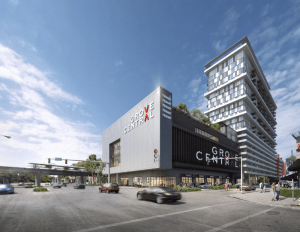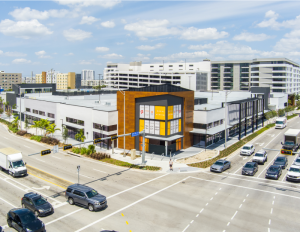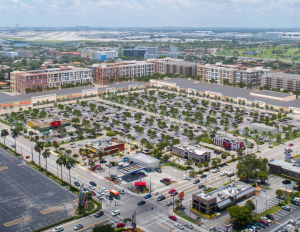Why Terra’s CEO Is Upbeat About South Florida Retail
David Martin expects the sector to continue to perform well. Here are the reasons behind his optimism.

The Florida retail sector has been thriving due to the influx of new residents and businesses moving to the city, according to David Martin. Image courtesy of Terra
Over the past few years, South Florida has remained a sought-after destination for both residents and tourists due to, in part, the myriad of entertainment options and year-long outdoor activities. The robust demographic increase and constant flow of visitors have been supporting the area’s retail sector, which has maintained low vacancies and positive net absorption, according to a recent Matthews report.
To take the pulse of the market, Commercial Property Executive reached out to Terra CEO David Martin, who has been an active developer in South Florida for more than two decades. Besides residential projects, Terra’s portfolio includes multiple retail and mixed-use developments across several Miami neighborhoods.
“I think we are well positioned to say this city is resilient, and there is no better place to be in right now than Florida,” said Martin. Here’s what makes him keep his optimism, despite the well-known challenges impacting the retail sector.
What would you identify as significant headwinds for developers today? What specific challenges do retail developers need to overcome?

Grove Central will include a mix of retail, residential units and a public parking garage. Image courtesy of Terra
Martin: In today’s real estate market, scarcity of land, elevated construction costs and year-over-year rent growth continue to be a challenge for many developers in South Florida and across the country.
Pertaining specifically to the retail sector, it’s challenging to create a retail environment that meets the needs of today’s consumers. With an influx of people moving to Florida, curating a retail mix that caters to the demand and needs of specific neighborhoods based on their demographics is critical.
When developing or investing, research is one of Terra’s biggest priorities. Our firm researches the wants and needs of our consumers and the community, to harness a business strategy that’s going to favor all.
Considering the economic environment today, what is the number one financial challenge faced by the retail sector?
Martin: The biggest challenge many sectors are facing today—including the retail sector—is securing financing. Interest rates continue to rise and stricter underwriting requirements are fueling tightening financial conditions.
Even though the retail sector has been facing these challenges, in Florida we continue to see the retail sector thrive—an influx of new residents and businesses moving to the city are presenting opportunities.
READ ALSO: What Retail Investors Want Now—A View From Transwestern
We’ve seen a widespread shift toward more experiential and entertainment-focused retail concepts across the country. What do you think about this trend? Where do traditional brick-and-mortar stores still work?
Martin: At Terra’s suburban locations, grocery-anchored retail development is performing strongly. The demographic in the suburbs will probably be older and looking for a traditional grocery experience.
We have seen experiential and entertainment-focused retail perform well in the urban markets and denser neighborhoods. In an urban market, you’ll likely be targeting a younger demographic that is looking for a different type of experience—restaurants, wellness concepts and less grocery or services you can shop online for.
There also seems to be a rise in neighborhood and community shopping centers. Do you expect this to become the new standard in retail?
Martin: This is certainly an interesting shift and it’s something we might continue to experience if the population in Florida continues to grow at the current rate. Another factor is the availability of land to develop in the suburbs. This is one of Miami’s greatest challenges—the scarcity of land and urban development boundaries have not kept up with South Florida’s growth.
Give us some details about Terra’s most recent projects.

Doral Atrium is a fully leased lifestyle-driven retail center recently completed by Terra. Image courtesy of Terra
Martin: In late 2020, we acquired a 1950’s shopping plaza in West Miami-Dade County with the intention of renovating the center and developing the excess land around it for multifamily, with the goal of creating a true urban mixed-use destination in a growing area of Miami. This idea grew into what today is CentroCity, a 38-acre, master-planned, mixed-use development which will include up to 1,200 market-rate residential apartments and about 300,000 square feet of newly revamped lifestyle-oriented retail and restaurant space anchored by Target. Construction is underway and we are currently nearing completion on the extensive renovation of the shopping plaza which will also include a new construction component featuring Ross, Five Below and other retail tenants.
In Miami’s Coconut Grove neighborhood, we are about to complete Grove Central, a mixed-use transit-oriented development in partnership with Grass River Property and Miami-Dade County. The transformative project will include multifamily/workforce apartments, a public parking garage and a total of 170,000 square feet of neighborhood-oriented retail space with tenants including Target, Sprouts Farmers Market, Total Wine, Club Studio and Five Below. Grove Central will also connect to and facilitate privately funded improvements made to the adjacent Coconut Grove Metrorail station and integrate directly with The Underline linear park, Miami-Dade’s bus system and the City of Miami’s popular trolley network.
In Miami’s City of Doral, we recently completed two fully leased lifestyle-driven retail destinations, Doral Square and Doral Atrium.
What other notable trends should we keep an eye on within the sector?
Martin: The retail sector is welcoming more service-oriented tenants that drive foot traffic to shopping centers. Terra has capitalized on this trend by sourcing complementary concepts in our retail centers. The idea is to have people visit not only one place, but two or more at the same center. For example, if we have a Yoga or Pilates tenant, having a juice bar, wellness café, or something related to fitness nearby is critical for the shopping center’s success.
READ ALSO: Navigating the Retail Financing Landscape—Peachtree Group’s CEO Weighs In
What are your company’s short- and long-term plans?
Martin: Terra’s goal and mission is to have a positive impact on the communities we build in—creating jobs, enhancing neighborhoods, adding green spaces and transforming communities to enable people to be successful and happy in their daily lives. We also want to stir economic growth and be a positive stakeholder in the community.
From an economic perspective, the company has been building condos for the last 20 years. We are moving beyond being a traditional condo developer in South Florida and focusing on a diversified asset portfolio—including multifamily, industrial, retail and much more. This focus aims to create a portfolio of diversified, steady and safe assets.
As we approach the end of 2023, how would you describe the year for the retail market, and what are your expectations heading into 2024?
Martin: The retail market in South Florida continues to be strong—with healthy sales reports and lack of new inventory over the years providing a positive balance of supply and demand. We are facing a bright outlook for the market and a strong forecast heading into 2024—which will, of course, depend on the impact of rates and how this will pose a threat to consumer spending.








You must be logged in to post a comment.